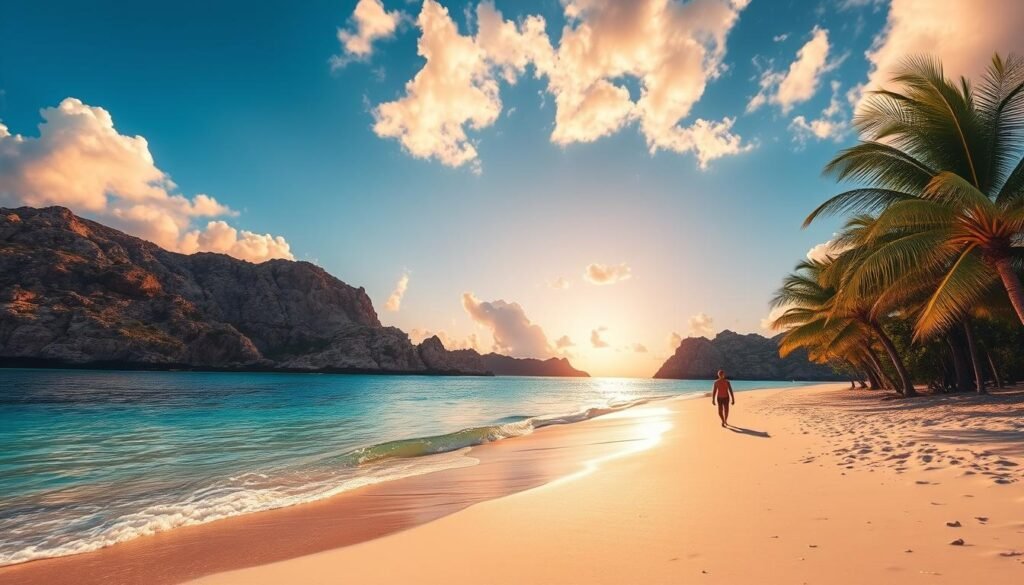Did you know Aruba gets under 20 inches of rain a year and averages about 82°F (28°C)? That makes this island unusually dependable for sunny days and steady trade winds.
I write from experience so you can plan a trip that fits your style and budget. I weigh weather, events, and crowds to help you choose when to travel.
High season brings prime weather and lively energy, while shoulder months offer better deals and fewer tourists. Low season can mean savings and greener scenery after brief showers.
I’ll preview beaches, snorkeling, wind sports, and marquee events like Carnival and the Soul Beach Music Festival so you can align an event with your plans.
Key Takeaways
- I explain how weather and seasons shape your trip planning.
- Aruba’s location outside the hurricane belt makes it a reliable destination year-round.
- High season = buzz and higher prices; shoulder months = value and space.
- I highlight top events so you can sync travel with culture and music.
- Practical tips on prices, crowds, and activities help travelers book smarter.
Aruba’s Year-Round Weather at a Glance: Climate, Temperatures, and Trade Winds
I’ll walk you through Aruba’s steady climate so you can match weather and activities with confidence.
Why location matters: Aruba sits outside the hurricane belt, which gives you reliable windows for travel and fewer storm-related surprises. That makes planning a time visit aruba far more predictable than many Caribbean islands.
Temperatures and rainfall: Average temperatures hover near 82°F (28°C) year-round, and annual rainfall is under 20 inches. The low rainfall usually appears as brief showers, not long washouts, so beaches and outdoor plans stay viable most days.You can learn more about best-places-to-visit-in-europe.
Sea conditions and visibility
Steady trade winds keep the air comfortable and limit humidity. Waters are calm enough for snorkeling and diving all year. The calmest seas and top visibility often occur from April through June, which is ideal if you want glassy conditions.
- Noted dive sites: the Antilla wreck and Mas Bango Reef—great for guided outings.
- Winds can affect surface chop, but currents remain friendly for most tours.
- Pick morning hikes or water tours when winds are gentler and sun intensity is lower.
How I use this: I match weather data to your travel style—whether you crave mellow swims, breezy watersports, or clear diving days—so you can choose the right period or season with confidence.
High Season in Aruba: January to March for Prime Weather and Festive Energy
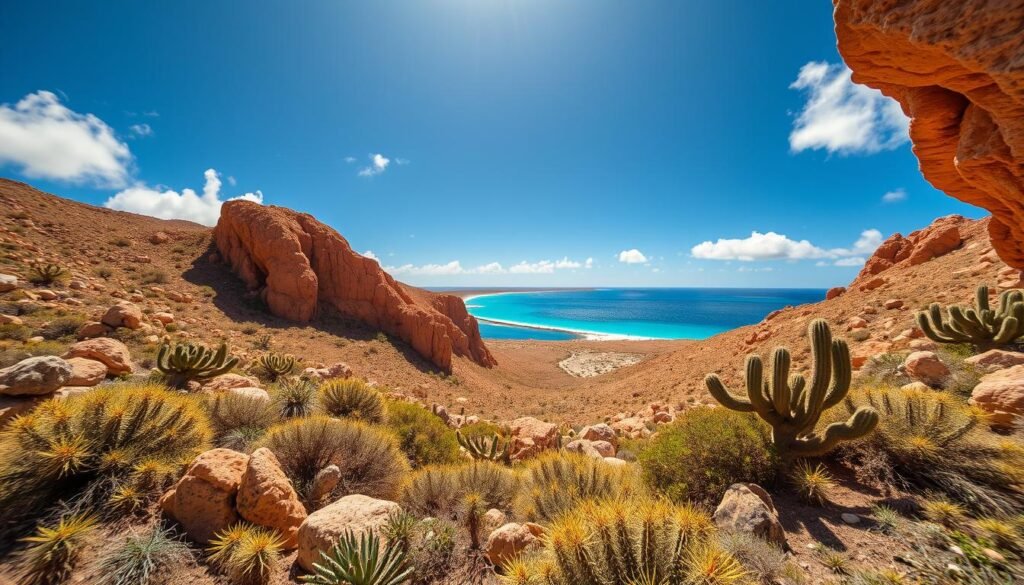
From January into March, Aruba hums with sunny skies and a high-energy atmosphere. These months deliver clear weather and steady trade winds, with average temperatures near 82°F (28°C).
Events and culture shine in January and February when Carnival parades fill streets with music, color, and dancing. The island’s atmosphere feels electric and lively nights ripple through Oranjestad and resorts.You can learn more about best-time-to-visit-greece.
Top activities
Windsurfing and kiteboarding thrive on strong winds. Guided tours into Arikok National Park reward early risers with dramatic coastal views, dunes, and caves.
Crowds and prices
Expect peak crowds and higher prices. I recommend booking flights, hotels, tours, and restaurant reservations well in advance to avoid last-minute stress.
“Book months ahead and plan morning hikes for quieter trails, then ride the breeze for afternoon water sports.”
- Balance beach afternoons with culture-forward evenings.
- Reserve popular tours and restaurants early.
- Use local transport or short taxis during busy peak month shifts.
Shoulder Season: April to August Sweet Spot for Fewer Crowds and Great Conditions
April through August offers a relaxed rhythm on the island, with warm days and lighter crowds that make exploring easy. Temperatures climb into the low 80s and can hit the high 80s, so the sea stays inviting for most activities.
Warm seas and steady breezes: snorkeling, diving, and glass-bottom tours
Sea visibility is often excellent in this period. I recommend morning snorkeling trips for calmer water and clearer views of reefs and wrecks.You can learn more about best-time-to-visit-switzerland
Beginner-friendly dives, guided reef tours, and glass-bottom boat options suit mixed groups. Book a half-day tour and bring sun protection, water, and reef-safe sunscreen.
Signature events: King’s Day and the Soul Beach Music Festival
Key events punctuate the months: King’s Day on April 27 and the Soul Beach Music Festival in May. The festival brings beach music acts and lively night shows.
- Plan evenings around performances and buy festival passes early.
- Choose midweek stays to lower costs and boost upgrade chances.
Adventure ideas: off-roading the north coast and exploring cave art
Off-road excursions along the north coast deliver rugged views and stops at cave art sites in Arikok National Park. I pack a hat, plenty of water, and sturdy shoes for these tours.
| Activity | Ideal Months | Crowd Level | Quick Tip |
|---|---|---|---|
| Snorkeling & Glass-Bottom Tours | Apr–Aug | Fewer crowds | Book mornings for best visibility |
| Music Festival & Night Events | May (Soul Beach) | Moderate | Buy tickets early; expect lively nights |
| Off-Road North Coast | Apr–Aug | Low to moderate | Bring water and sun protection |
| Arikok National Park Hike | Apr–Aug | Fewer crowds | Start early to avoid midday heat |
“This shoulder period gives you a little beach, a little culture, and a lot of easy-going fun.”
For a compact planning read, check my best time to visit guide for extra booking tips and calendar notes.
Low Season: September to December for Savings, Space, and Lush Landscapes
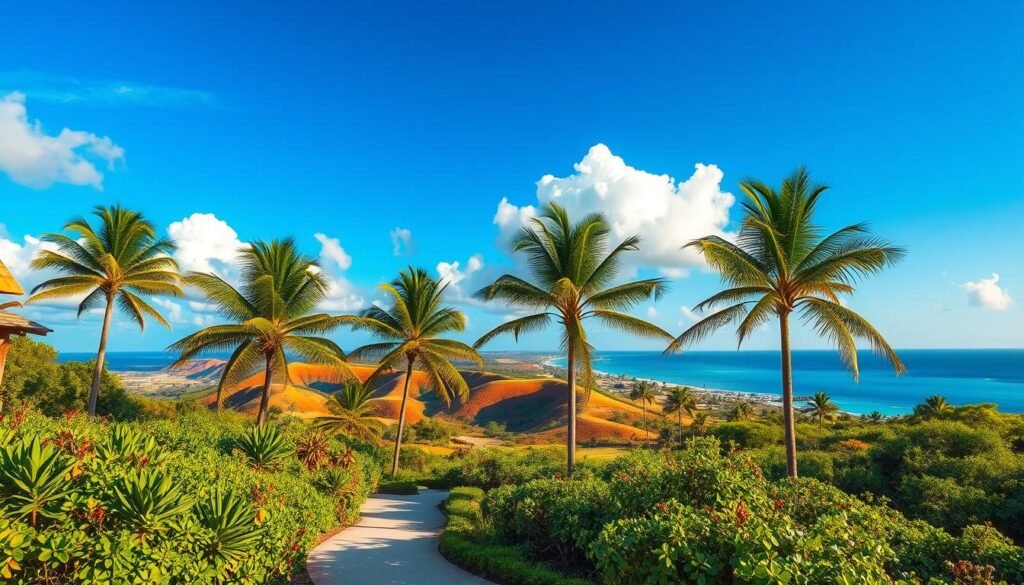
When crowds thin from September through December, the island shows a softer, greener side and wallet-friendly deals. Showers are usually brief and heavy, then the sun returns and the landscape perks up.
Weather pattern and days outdoors
Temperatures sit around 78–85°F (26–29°C), with cooler evenings that feel great for dinners al fresco. Rainfall tends to fall in quick bursts, refreshing plants and improving visibility for bird watching.
Wallet-friendly travel and quieter beaches
I find prices for hotels and flights dip in these months, and beaches often feel almost private. Booking flexible dates can unlock the best flight values and room upgrades.
Events, culture, and nature moments
Seasonal events include the Aruba Art Fair in September, Eat Local Restaurant Month in October, and December’s Dande traditions. Museums and galleries are peacefully uncrowded, and dive sites often calm after rain.
“This season is ideal for travelers who want value, culture, and space to breathe without losing island beauty.”
- Packing tip: a light rain jacket, quick-dry layers, and reef-safe sunscreen.
- Plan nature mornings for birding and calmer water tours after showers.
- For local insight and seasonal travel tips, check my seasonal travel tips.
The Best Time to Visit Aruba
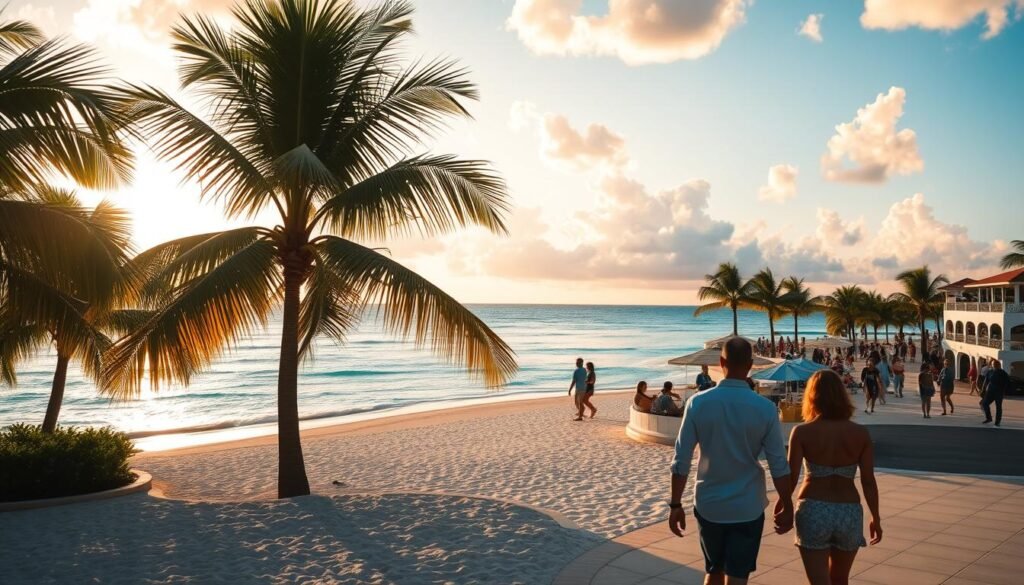
I pick dates by balancing weather and the kind of atmosphere I want on the island. Sunshine, events, and sea conditions shape my choice more than fixed calendar rules.You can learn more about best-time-to-visit-thailand
When I’d go for peak weather and lively atmosphere
My pick for peak weather and buzz is January–March. Those months bring steady sun, low rainfall, and Carnival energy that fills the streets.
If you chase lively nights, beach parties, and strong wind for water sports, this is your season. Plan ahead: flights and hotels fill and prices climb.
“January through March blends clear skies with island festivals—great for travelers who want action and excellent weather.”
When I’d go for fewer crowds, lower prices, and a relaxed vibe
I favor June–November when I want fewer crowds and softer prices. July–August often has the lightest visitor volume and the best bargains.
If calm seas for snorkeling matter most, I aim for April–June—visibility is usually excellent and tours run smoothly.
| Goal | Months | Why |
|---|---|---|
| Peak weather & atmosphere | Jan–Mar | Sunshine, Carnival, lively nightlife |
| Fewer crowds & lower prices | Jun–Nov | Off-peak rates, quieter beaches |
| Calmest seas for snorkeling | Apr–Jun | Top water visibility and gentle conditions |
My quick rule: choose weather and atmosphere first, or prioritize budget and space. Either way, this destination delivers year after year.
For official season guidance and booking windows, check when to visit.
Planning Your Trip: Prices, Crowds, Flights, and Must-See Beaches
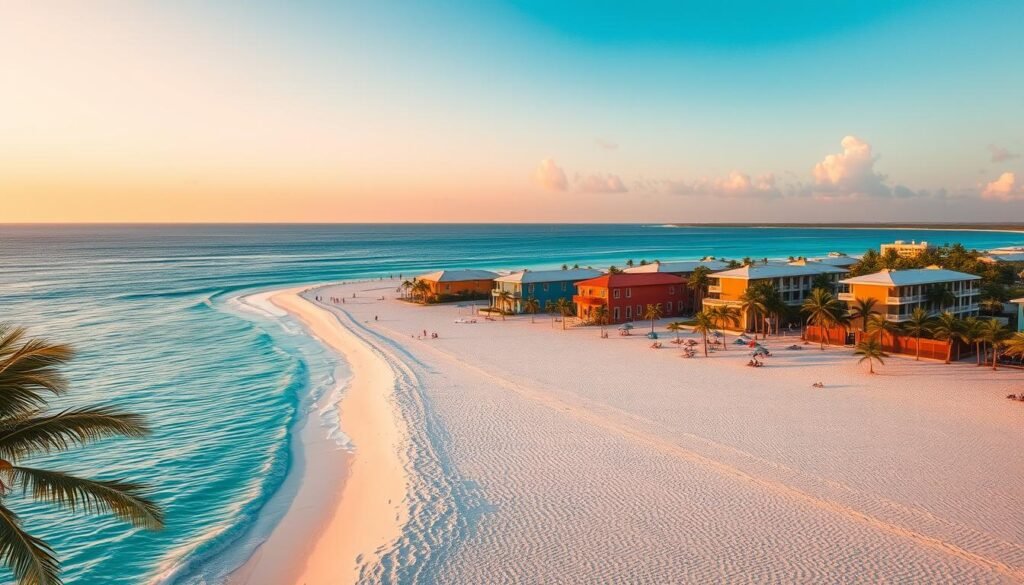
A few scheduling choices make flights cheaper and let you enjoy Eagle Beach without the rush.
Cheaper periods most often fall between June and November. I watch fares and book midweek stays for the best savings. Flexible dates, fare alerts, and package bundles cut costs further.
How to book smart and when fares dip
Peak season runs mid-December through mid-April. During that period I reserve hotels, tours, and restaurants early to avoid sold-out frustration.
For the greatest value, aim for the shoulder or off-peak period—June through November—and use alerts for last-minute deals on flights and rooms.
Finding calm on Eagle Beach and Palm Beach
July and August often show the lowest crowds. Early mornings and late afternoons offer the quietest stretches on Eagle Beach and Palm Beach.
Scout side access points and public parking areas to find peaceful pockets away from busy hotel strips.
Timing tours, national park hikes, and water conditions
The calmest sea conditions for snorkeling and diving usually appear April–June. I schedule water tours in the morning for clearer visibility.
Arikok National Park is best on early hikes. Start before midday to beat heat and wind and to enjoy shaded trails and scenic lookouts.
“Sunrise beach walks, a mid-morning tour, a siesta, and a golden-hour swim make a perfect island day.”
| Plan Item | Ideal Period | Tip |
|---|---|---|
| Cheapest flights & stays | Jun–Nov | Use flexible dates and fare alerts |
| Quiet beaches (Eagle Beach) | Jul–Aug; mornings | Choose side access and arrive early |
| Calmest water for snorkeling | Apr–Jun | Book morning tours for best visibility |
| Arikok National Park hikes | Year-round, mornings best | Bring water, hat, and sturdy shoes |
Festival note: Events like Soul Beach Music Festival affect availability and prices. Decide whether you want the energy of a music festival or the quiet of off-peak periods, then book accordingly.
Conclusion
I want you to leave feeling ready to pick dates that match the kind of trip you want.
Aruba offers steady weather and low annual rainfall, making this island a reliable destination for many travelers. Pick peak months for lively events and sun, or choose shoulder and off-peak months for lower costs and quieter beaches.
Match your goals: sync your stay with Carnival, Soul Beach Music, or local arts and food festivals if culture and events matter. If calm seas and snorkeling top your list, aim for months with the clearest water.
Whichever season you choose, the island’s beauty and predictability make planning a smooth part of the vacation. I hope this guide helps you book with confidence and enjoy every moment of your trip.


